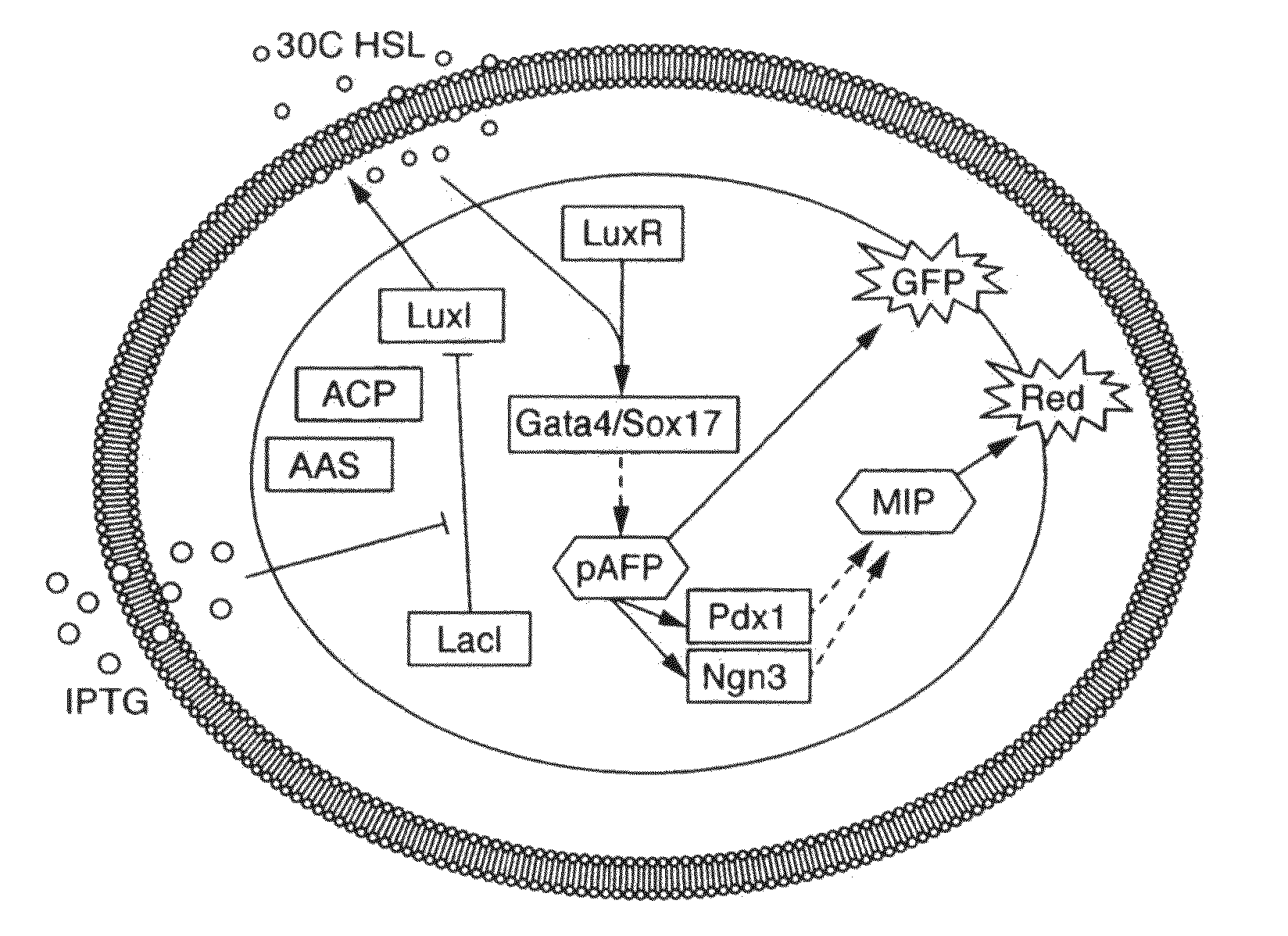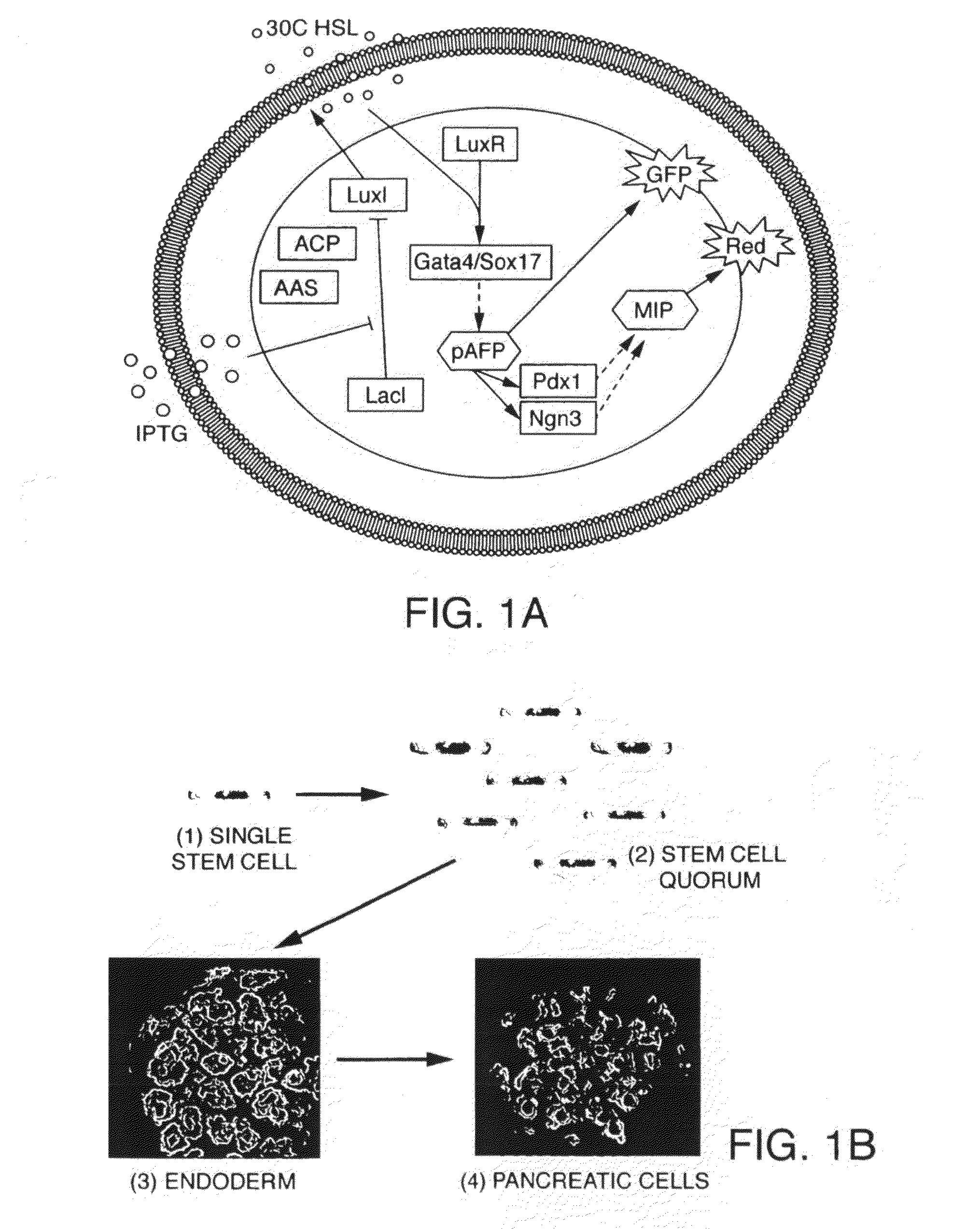Engineered cellular pathways for programmed autoregulation of differentiation
a technology of autoregulation and cellular pathways, applied in the field of mammalian cell programming, can solve the problems of inability to direct the production of desired cell populations, inability to create and maintain precise conditions that are required for tissue re-generation using such means, and inability to achieve the effect of inhibiting cell growth
- Summary
- Abstract
- Description
- Claims
- Application Information
AI Technical Summary
Benefits of technology
Problems solved by technology
Method used
Image
Examples
example 1
[0313]293FT cells that were genetically engineered to synthesize 30C6HSL were grown in liquid media, and this media was found to contain 30C6HSL (FIG. 2a). The 30C6HSL detection pathway consists of a signal transducer that binds 30C6HSL and activates transcription of genes controlled by a synthetic lux promoter. The 30C6HSL signal transducer is a chimeric LuxR-activator protein created by the fusion of a P65 mammalian activation domain to a codon optimized mammalian version of a bacterial LuxR. Initial testing of the mammalian version of LuxR in 293FT cells shows a strong response to the addition of 30C6HSL (FIG. 2b).
example 2
[0314]Synthetic gene networks in mammalian cells—the rtTA switch. A reverse Tetracycline-controlled transactivator (rtTA) switch, where gene expression is upregulated by the addition of Doxycycline (Dox), has been implemented. rtTA is constitutively expressed in the Ainv15 mES cell line and activates transcription of a give cell fate regulator (CFR) and a EGFP as control from the TRE promoter in the presence of Dox. A dosage response curve (not shown) demonstrates that the expression level (as measured by flourescence depending of the Dox concentration.
[0315]Controlled induction of cell fate regulators in mES. Ngn1, MyoD and Nanog Ainv15 mES stem cells constitutively expressing the Dox-inducible circuit can be infected with a virus encoding Ngn1 / EGFP or MyoD / EGFP under the control of a TRE promoter. The cell maintains self-renewal in the absence of Dox, while the presence of Dox results in the differentiation into either cells with a neuronal morphology (Ngn1), muscle cell morpholog...
example 3
[0317]293FT and CHO cells were infected with virus encoding pLV-pTat-IRES2-EGFP, and then exposed three different types of TAT communication molecules with various secretion tags. The 293FT cells are able to internalize the TAT protein, while CHO cells cannot. In the experiment, sender cells were grown for 2 days, and then receiver 293FT cells were grown in the supernatant. As expected, the supernatant from 293FT cells that can internalize the TAT molecule did not yield much communication, while supernatant from the CHO cells was able to active GFP expression significantly in the receiver cells.
PUM
| Property | Measurement | Unit |
|---|---|---|
| Nucleic acid sequence | aaaaa | aaaaa |
| Cell growth | aaaaa | aaaaa |
Abstract
Description
Claims
Application Information
 Login to View More
Login to View More - R&D
- Intellectual Property
- Life Sciences
- Materials
- Tech Scout
- Unparalleled Data Quality
- Higher Quality Content
- 60% Fewer Hallucinations
Browse by: Latest US Patents, China's latest patents, Technical Efficacy Thesaurus, Application Domain, Technology Topic, Popular Technical Reports.
© 2025 PatSnap. All rights reserved.Legal|Privacy policy|Modern Slavery Act Transparency Statement|Sitemap|About US| Contact US: help@patsnap.com



